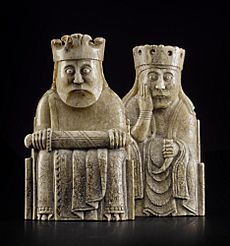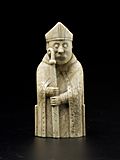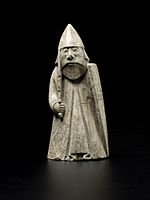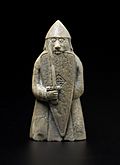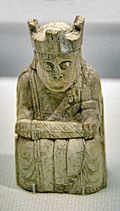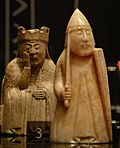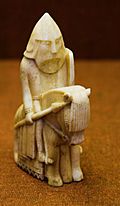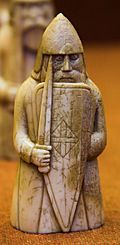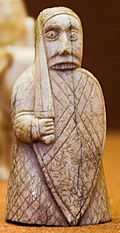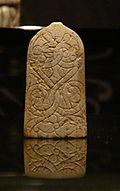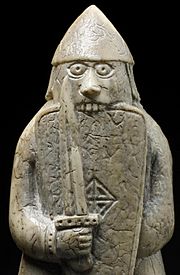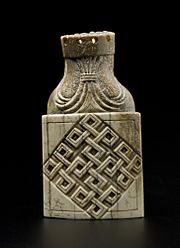Game pieces of the Lewis chessmen hoard facts for kids
Quick facts for kids Lewis chessmen |
|
|---|---|
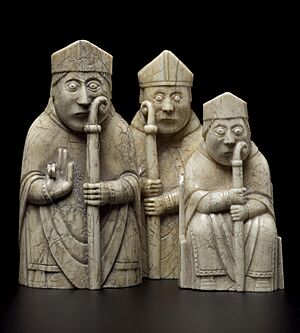
Lewis chessmen in National Museums Scotland
Three bishops (H.NS 24, 25 & 26) |
|
| Material | Walrus ivory and whale tooth |
| Created | 12th century |
| Discovered | 1831 or earlier Mealista, Isle of Lewis 58°06′14″N 7°06′29″W / 58.104°N 7.108°W |
| Present location | |
The ninety-three game pieces of the Lewis chessmen hoard were found on the Isle of Lewis in the Outer Hebrides of Scotland. Medieval in origin, they were first exhibited in Edinburgh in 1831 but it is unclear how much earlier they had been discovered. The hoard comprised seventy-eight distinctive chess pieces and fifteen other non-chess pieces, nearly all carved from walrus tusk ivory, and they are now displayed at the British Museum in London and National Museums Scotland in Edinburgh. Another chess piece, which turned up in 1964 and in 2019 was attributed to have come from the original hoard, now belongs to an undisclosed owner.
The style of carving, particularly that on the thrones of the seated figures, suggests they are Scandinavian in origin, most likely from Trondheim, the medieval capital of Norway until 1217.
The types of piece are similar to those in modern chess – the chessmen are the earliest found that have figures in clerical dress (bishops). The rooks are represented as warriors which came to be called "warders" at an early stage after they were discovered. Four of the warders are shown biting their shields – these have been identified as the berserkers of the Norse sagas. Christian and pagan influences are both present in the designs.
Contents
Provenance of hoard
The hoard of ninety-three games pieces was found on the Isle of Lewis and was exhibited in Edinburgh in 1831. Most accounts have said the pieces were found at Uig Bay (58°11′10″N 7°01′19″W / 58.185987°N 7.021909°W) on the west coast of Lewis but Caldwell et al. of National Museums Scotland (NMS) consider that Mealista (58°06′14″N 7°06′29″W / 58.104°N 7.108°W), also in the parish of Uig and some 6 miles (10 km) further south down the coast, is a more likely place for the hoard to have been discovered. The hoard was divided and sold in the 19th century – the British Museum (BM) holds eighty-two pieces and National Museums Scotland has the other eleven pieces.
At the British Museum it was Sir Frederic Madden, Assistant Keeper of Manuscripts, who persuaded the Trustees to purchase for 80 guineas (£84) the eighty-two pieces which he had been misled into believing was the entire hoard. Madden was a palaeographer, a scholar of early vernacular literature, but he was especially intrigued by these artifacts because he was a chess enthusiast. Madden immediately set about writing a monumental research paper about the collection, Madden (1832) – one that remains informative and impressive today. At both museums the chessmen are an extremely popular exhibit for visitors.
A chess piece was purchased in Edinburgh in 1964 but it was not recognised at the time for what it was – it is now thought to have been made by the same people who made the pieces in the hoard and it was probably originally part the hoard itself. This piece was sold at auction in 2019 for £735,000.
Attributes of types of piece
There are 79 chess pieces including the one recently found, a warder. Of these pieces, 60 are major pieces and 19 are pawns. In addition to these there are 14 plain ivory discs. There is also a single ivory buckle which might have been part of a bag holding the hoard. The pieces are carved from walrus tusk ivory except for at least three made from whale tooth. None of the pieces now show any sign of colouring, even under detailed scrutiny, but in 1832 Madden reported several pieces as being coloured red, some deeply so.
| Type | Number | No. in BM |
|---|---|---|
| Kings | 8 | 6 |
| Queens | 8 | 5 |
| Bishops | 16 | 13 |
| Knights | 15 | 14 |
| Warders | 13 | 10 |
| Pawns | 19 | 19 |
| Discs | 14 | 14 |
| Buckle | 1 | 1 |
| sum | 94 | 82 |
The major pieces all have attributes showing what type of piece they are. The kings and queens are seated on thrones. The kings have long braided hair (except one) and hold in their right hand a sheathed sword resting across their knees. They wear a long mantle fastened at the right shoulder over various other types of clothing, and their crown has four trefoils. The queens are all cupping their chin in their right hand. Their long hair in braids is covered with a veil and their crown is either like the kings' or has a continuous pierced band. Covering their gown, the queens have a long mantle or cloak leaving a gap at the front.
The bishops are most variable in design – some are standing and others are seated and they are dressed in one of two types of liturgical vestments: five wear a cope over a tunicle, and the others wear pontifical vestments: a chasuble and stole over a dalmatic, over an alb. They are all clean-shaven, wear a mitre over their cropped shoulder-length hair, and are holding a crozier with one or both hands. Some bishops are holding a book or are giving a blessing.
The knights have beards and moustaches and are mounted on rather small horses equipped with stirrups and bridles. They are wearing long gambesons with belts and are carrying spears and long, narrow kite-shaped shields. When they carry swords they are hung from a baldric over the shoulder.
The warders have long straight hair and they are all standing with drawn swords, variously shaped helmets, and shields – four warders are biting their shields. Most are wearing long gambesons but a few wear chain mail, usually incorporating a chain mail hood.
| British Museum image of disc, 54 mm diameter (1831,1101.155) |
The pawns are not figurative in design and are either bullet-shaped or slab-like. Two have some engraved ornamentation. The discs are very plain with two or three inscribed circumferential circles.
List of pieces
| Catalogue number | Type | Height (mm) | Weight (g) | Image (link) | Group/ Set | Notes |
|---|---|---|---|---|---|---|
| none (3D) | warder | 88 | Sotheby's (2019) | Wearing gambeson, conical helmet (point damaged) with ear flaps. Neck flap lost through damage. Face damaged. Bought for £5 in 1964 with unknown provenance; sold in 2019 for £735,000. | ||
| H.NS 19 (3D) | king | 96 |
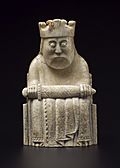
also rear & side
|
D2 | Bearded. Wearing a dalmatic under mantle. | |
| H.NS 20 (3D) | king | 73 | X4 | Wearing a tunic under mantle. | ||
| H.NS 21 (3D) | queen | 92 |

also rear
|
D2 | Wearing a long cloak over a long-sleeved gown. | |
| H.NS 22 (3D) | queen | 70 | C4 | Wearing cloak over knee-length long-sleeved gown and undergarment. The left side of the throne is from a separate piece of ivory, pinned on at the time of original manufacture. | ||
| H.NS 23 (3D) | queen | 93 | D2 | Holding a drinking or money horn. | ||
| H.NS 24 (3D) | bishop | 92 | E2 | Seated on throne, wearing cope over chasuble. Grasping crosier with both hands. | ||
| H.NS 25 (3D) | bishop | 93 | D2 | Standing. Wearing pontifical vestments. Right hand blesses and left hand holds crosier. | ||
| H.NS 26 (3D) | bishop | 73 |
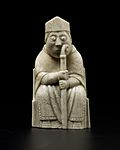
rear & side
|
B4 | Seated on throne, wearing pontifical vestments. Grasping crosier with both hands. | |
| H.NS 27 (3D) | knight | 89 |
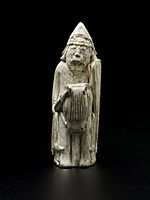
rear & side
|
X2 | Wearing conical helmet. Bearing spear. Carved from sperm whale tooth. | |
| H.NS 28 (3D) | warder | 92 | E2 | Wearing gambeson, sword raised. Carved from sperm whale tooth | ||
| H.NS 29 (3D) | warder | 82 | E3 | Berserker. Wearing gambeson, biting the top of shield with sword raised. | ||
| 1831,1101.78 (3D) | king 1 |
98 | 215 | A1 | Bearded. Crown with floral design. Brooch on mantle over tunic. Sheathed sword. Chair back with floral scrolls and dragon with floral tail. Interlaced designs on sides. | |
| 1831,1101.79 | king 2 |
99 | 245 | D1 | Beardless. Seated on high-backed chair holding sheathed sword. Crown with floral design. Brooch, mantle over tunic. Chair back with floral scrolls, upper ones held by animals' heads on uprights. Sides with interlaced decoration. | |
| 1831,1101.80 (3D) | king 4 |
89 | B3 | Bearded. Seated upon high-backed chair holding sheathed sword. Wearing floral crown, mantle over tunic and brooch. Chair back decorated with floral scrolls framed by two heads of animals. Madden described this as originally red. | ||
| 1831,1101.81 | king 5 |
91 | B3 | Beardless, shoulder-length hair. Sword with baldric wound around. Guard decorated. Back of throne decorated with animal heads at top of uprights framing symmetrical leaf-scrolls. Damaged crown. | ||
| 1831,1101.82 (3D) | king 3 |
95 | X2 | Bearded. Crown with hatched band. Back of throne decorated with three vertical panels of trefoils, geometric interlace and sinuous scrolls. Damaged sword. | ||
| 1831,1101.83 | king 6 |
79 | C4 | Bearded, wearing floral crown, mantle over tunic and brooch. Seated holding sheathed sword. High chair back has two horizontal compartments separated by zigzag, upper with interlaced arches, lower floral designs. Chair sides with interlacing. | ||
| 1831,1101.84 | queen 1 |
96 | 156 | C1 | Holding drinking or money horn. Floral crown over veil. Seated in chair ornamented on back with leaf scrolls and animal heads on uprights. Chair sides have interlaced design. | |
| 1831,1101.85 | queen 5 |
80 | B3 | Crown (damaged) decorated with pierced hole. One hand around knee holding a cloth, maybe a veil. Back of throne decorated possibly with facing lions with floral tails. | ||
| 1831,1101.86 (3D) | queen 4 |
80 | B3 | Floral crown, veil, mantle over gown. Chair ornamented on back with two animals back-to-back with floral extremeties. Animal heads on top of uprights. Madden described this as very deep red. | ||
| 1831,1101.87 | queen 3 |
76 | X4 | Back of throne divided into two panels, upper decorated with foliage, lower with interlaced arches. Sides decorated with panels of foliage. Damaged crown. | ||
| 1831,1101.88 (3D) | queen 2 |
97 | C1 | Seated, wearing floral crown, veil, mantle over gown. Chair back with leaf scrolls. Cloth hanging over top of back of chair. | ||
| 1831,1101.89 | bishop 2 |
97 | D1 | Seated wearing pontifical vestments, holding book. Back of throne decorated with two panels of leaf scrolls. | ||
| 1831,1101.90 | bishop 1 |
97 | D1 | Seated wearing pontifical vestments, low mitre with lappets. Right hand raised in blessing. Back of chair has two pairs of adjacent leaf-scrolls. | ||
| 1831,1101.91 | bishop 3 |
87 | B3 | Seated wearing pontifical vestments, hand raised, back of throne decorated with leaf scrolls. Damaged crozier. | ||
| 1831,1101.92 | bishop 4 |
82 | B4 | Seated wearing pontifical vestments, holding book. back of throne decorated with overlapping arcades and interlace. Madden described this as originally red. | ||
| 1831,1101.93 | bishop 5 |
82 | D4 | Seated wearing pontifical vestments, holding book. Back of chair fretwork, top cross-bar with animal heads. Chair sides incised parallelograms and semicircles. Madden described this as very deep red. | ||
| 1831,1101.94 | bishop 11? |
89 | C3 | Standing wearing cope. | ||
| 1831,1101.95 | bishop 8? |
95 | C2 | Standing wearing cope and mitre with lappets. Madden described this as originally red. | ||
| 1831,1101.96 | bishop 12 |
95 | C1 | Standing wearing cope. | ||
| 1831,1101.97 | bishop 13? |
76 | B4 | Standing wearing pontifical vestments. Damaged crozier. | ||
| 1831,1101.98 (3D) | bishop 7 |
95 | 179 | D2 | Standing wearing cope and mitre with lappets. Holding book. | |
| 1831,1101.99 | bishop 9 |
83 | C3 | Standing wearing cope. Holding book. | ||
| 1831,1101.100 | bishop 6 |
102 | 150 | C1 | Standing wearing pontifical vestments. Holding book. | |
| 1831,1101.101 | bishop 10 |
83 | C3 | Standing wearing pontifical vestments. Holding book. Madden described this as red. | ||
| 1831,1101.102 | knight 13 |
73 | C4 | Wearing kettle hat. Sword. Shield divided in halves horizontally with interlaced saltire on cross-hatched ground. Madden described this as red. | ||
| 1831,1101.103 | knight 10 |
73 | C4 | Wearing kettle hat. Sword. Shield, halved vertically and to one side cross-hatched. | ||
| 1831,1101.104 | knight 9 |
88 | C3 | Bearded. Wearing kettle hat. Sword. Shield with saltire over a cross inside border. | ||
| 1831,1101.105 | knight 11 |
80 | X3 | Wearing kettle hat and spear in right hand. Shield with dotted bands making cross over central circle. Piece damaged and split. | ||
| 1831,1101.106 | knight 12 |
80 | X3 | Bearded, wearing conical helmet. Sword. Shield with interlaced saltire. | ||
| 1831,1101.107 (3D) | knight 8 |
84 | A3 | Bearded, wearing conical helmet. Sword. Shield with diamond shape inscribed in square. | ||
| 1831,1101.108 | knight 7 |
89 | A2 | Bearded, wearing conical helmet. Sword. Shield with cross and diamond shape in centre. | ||
| 1831,1101.109 | knight 14 |
79 | B4 | Wearing conical helmet with neck and ear-pieces decorated with St Andrew's cross. Sword. Shield with cross and square. | ||
| 1831,1101.110 | knight 5 |
91 | A2 | Conical helmet. Shield decorated with incised diamond shape. Damaged. | ||
| 1831,1101.111 | knight 6 |
90 | A2 | Conical helmet with neck and ear pieces. Long tunic with belt. Sword. Shield having cross with circles. | ||
| 1831,1101.112 | knight 3 |
103 | X1 | Conical helmet with neck and ear-pieces. Ornamented headband. Sword belt. Two quarters of shield cross-hatched. | ||
| 1831,1101.113 | knight 4 |
100 | 150 | A1 | Conical helmet with decorated neck and ear pieces. | |
| 1831,1101.114 | knight 2 |
101 | A1 | Conical helmet with neck and ear pieces with crescent decoration. Shield has cross with diamond shape over centre. | ||
| 1831,1101.115 | knight 1 |
100 | 163 | A1 | Wearing conical helmet with neck and ear-pieces. Shield with rectangle inscribed with saltire on cross. | |
| 1831,1101.116 | warder 2 |
100 | A1 | Bearded, wearing gambeson, conical helmet with neck and ear flaps. Shield to left side with diamond shape in centre. | ||
| 1831,1101.117 | warder 3 |
98 | A1 | Wearing gambeson, conical helmet with ear and neck flaps, kite shield and sword held upright. Face damaged. | ||
| 1831,1101.118 (3D) | warder 1 |
93 | A2 | Bearded, wearing gambeson. conical helmet with neck and ear flaps. Kite-shaped shield in front with cross inscribed in diamond shape. | ||
| 1831,1101.119 | warder 4 |
90 | D2 | Bearded, looking slightly sideways, wearing gambeson and conical helmet with neck and ear flaps, incised crosses and ornamented encircling head band. Kite-shaped shield with saltire within circle. Probably carved from whale tooth. | ||
| 1831,1101.120 | warder 5 |
89 | B3 | Bearded, wearing gambeson, conical helmet with central ridge, kite-shaped shield with incised cross and central square, sword held diagonally. Piece damaged. | ||
| 1831,1101.121 | warder 9 |
79 | X4 | Wearing gambeson, helmet ornamented with band of diamond shapes. Kite-shaped shield having cross with small concentric circles in centre plus zigzag ornament. Probably carved from whale tooth. | ||
| 1831,1101.122 | warder 10 |
71 | D4 | Wearing long pleated garment, baldric and kettle hat helmet with straight brim. Shield has cross with diamond shape. | ||
| 1831,1101.123 | warder 7 |
92 | X2 | Berserker. Chain mail, no hood, sword in scabbard and conical helmet with vertical fluting and band of dots. Shield with cross, each arm with double row of dots flanking median line. | ||
| 1831,1101.124 | warder 6 |
85 | 102 | C3 | Berserker. Enraged look. Chain mail, sword in scabbard, chain mail hood and conical helmet with encircling bands. Shield with cross with large circle in centre, inscribed with saltire. | |
| 1831,1101.125 (3D) | warder 8 |
82 | C3 | Berserker. Chain mail and chain mail hood with no helmet. Sword in scabbard. Shield has interlaced saltire. Madden described this piece as red. | ||
| 1831,1101.126 (3D) | pawn 1 |
59 | 62 | 59x33x23 mm. Ridged projection on top. Rounded top with trefoil knob, flat sides, front and back slightly convex. Probably carved from whale tooth. | ||
| 1831,1101.127 | pawn 6 |
51 | Decorated with pairs of leaf scrolls. Rounded top, flat sides, front and back slightly convex. | |||
| 1831,1101.128 | pawn 5 |
52 | Geometric interlace decoration. Rounded top, flat sides, front and back slightly convex. | |||
| 1831,1101.129 | pawn 2? |
56 | 51 | Rounded top, flat sides, front and back slightly convex. | ||
| 1831,1101.130 | pawn 3? |
80 | Front and back flat with bevelled edges. Not ornamented. | |||
| 1831,1101.131 (3D) | pawn 4? |
55 | 55x28x21 mm. Rounded top, flat sides, front and back slightly convex. | |||
| 1831,1101.132 | pawn 7 |
56 | Pointed top, crest has small knob. Octagonal section. | |||
| 1831,1101.133 | pawn | 51 | Pointed top. Octagonal section. Probably carved from whale tooth. | |||
| 1831,1101.134 | pawn | 40 | Pointed top. Octagonal section. | |||
| 1831,1101.135 | pawn | 40 | Pointed top. Octagonal section. | |||
| 1831,1101.136 | pawn | 40 | Pointed top. Octagonal section. | |||
| 1831,1101.137 | pawn | 40 | Pointed top. Octagonal section. | |||
| 1831,1101.138 | pawn | 40 | Pointed top. Octagonal section. | |||
| 1831,1101.139 | pawn | 40 | Pointed top. Octagonal section. | |||
| 1831,1101.140 | pawn | 40 | Pointed top. Octagonal section. | |||
| 1831,1101.141 | pawn | 40 | Pointed top. Octagonal section. | |||
| 1831,1101.142 | pawn | 40 | Pointed top. Octagonal section. | |||
| 1831,1101.143 | pawn | 40 | Pointed top. Octagonal section. | |||
| 1831,1101.144 | pawn | 40 | Pointed top. Octagonal section. | |||
| 1831,1101.145 | buckle | 63 | 10x29x63 mm. Front engraved with floral designs on hatched background. Tongue turning on copper wire. | |||
| 1831,1101.146 | disc | 50 | 50x11 mm. Two incised circles around circumference. | |||
| 1831,1101.147 | disc | 50 | 50x15 mm. Three incised circles around circumference. | |||
| 1831,1101.148 | disc | 52 | 52 mm diameter. Two incised circles around circumference. | |||
| 1831,1101.149 | disc | 49 | 49x13 mm. Two incised circles around circumference. | |||
| 1831,1101.150 | disc | 51 | 51 mm diameter. Two incised circles around circumference. | |||
| 1831,1101.151 | disc | 52 | 52 mm diameter. Two incised circles around circumference. | |||
| 1831,1101.152 | disc | 52 | 52 mm diameter. Two incised circles around circumference. | |||
| 1831,1101.153 | disc | 53 | 53 mm diameter. Two incised circles around circumference. | |||
| 1831,1101.154 (3D) | disc | 53 | 53 mm diameter. Two incised circles around circumference. | |||
| 1831,1101.155 | disc | 54 | 54 mm diameter. Two incised circles around circumference. | |||
| 1831,1101.156 | disc | 53 | 53 mm diameter. Two incised circles around circumference. | |||
| 1831,1101.157 | disc | 53 | 53 mm diameter. Two incised circles around circumference. | |||
| 1831,1101.158 | disc | 53 | 53 mm diameter. Two incised circles around circumference. | |||
| 1831,1101.159 | disc | 53 | 53 mm diameter. Two incised circles around circumference. |
Bishops, warders and berserkers
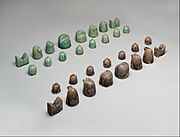
When chess was first developed in India, the piece that eventually became the bishop was the elephant and the rook was originally the chariot (called rukh in Persian). Under Islamic influence the pieces later became abstract in design. When the game spread into medieval Europe the design of most pieces returned to being figurative once more. The rook was an exception to this and thus the warrior rooks of the Lewis collection are unusual in this sense. The Lewis sets are the earliest to be found that include any sort of clerical figure, in this case bishops, although a few single pieces depicting bishops have been found that may be earlier.
In his 1832 research paper, Madden called the warriors "warders" to imply a status between that of foot soldier and knight – this name has stuck. Madden was the first person to understand that the pieces showing warriors biting their shields were representing berserkers – warriors who fought in a frenzied fury. From his scholarship in paleography Madden knew that the Norse sagas tell that berserkers were known for biting their shields. For example, in about 1225, writing in emerging Christian times but looking back to pagan times, the poet historian Snorri Sturluson wrote
Odin could make his enemies in battle blind, or deaf, or terror-struck, and their weapons so blunt that they could no more cut than a willow twig; on the other hand, his men rushed forwards without armour, were as mad as dogs or wolves, bit their shields, and were strong as bears or wild bulls, and killed people at a blow, and neither fire nor iron told upon them. These were called Bersærkers.
—Snorri Sturluson, Heimskringla
Carving on thrones
The kings, queens and seven of the bishops are seated on thrones with elaborately carved backs and sides. Deeply carved scrolls of foliage, sometimes including beasts, have frequently been used but on other pieces interlaced geometrical designs have been adopted. A horizontal or vertical bar may be used allowing more than one design to be displayed. The decorations on the thrones are often more boldly carved than on the figures themselves – the individual workman, freed from the need to produce a figure with specific attributes, could operate outside any tight constraints of a pattern book. Two pawns and the buckle have similar designs in shallow engraving. The back of the king's throne (H.NS 19) is shown above and the main table includes links to images of the backs and sides of some of the other pieces.


